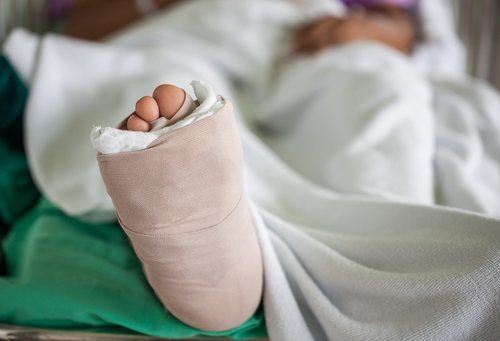When someone dies in California due to another person’s wrongful act, that person may be sued as a defendant in two types of lawsuits:
- The first is a “survival” cause of action, which compensates the victim’s estate for losses they suffered after the defendant’s wrongful act but prior to the victim’s death.
- The second is a “wrongful death” lawsuit, which compensates the next of kin for losses they incurred due to the death.
California Code of Civil Procedure 377.30 authorizes survival actions. They get their name because, under this law, the right to sue for damages “survives” the death of the decedent (deceased person).
Wrongful death and survival actions can be brought separately or combined into a single lawsuit. Their differences are illustrated in the following table:
| CALIFORNIA LAW | Survival Actions – CCP 377.30 | Wrongful Death Lawsuits – CCP 377.60 |
| Plaintiff | Personal representative of the deceased’s estate | The deceased’s surviving family members |
| Compensatory Damages | Medical expenses incurred before death, lost wages before death, property damage, pain and suffering before death | Loss of financial support, loss of companionship, loss of services, pain and suffering, and funeral and burial expenses |
| Punitive Damages | May be available if the deceased would have been entitled to them had they lived | Generally not available |
| Statute of Limitations | Generally 2 years from the date of injury or 6 months after death, whichever is later | Generally 2 years from the date of death |
To help you better understand survival causes of action, our California personal injury lawyers discuss:
- What are survival actions?
- Who brings them?
- Compensatory Damages
- Punitive Damages
- Statute of Limitation
- Additional Resources

When death results from someone’s negligence, recklessness or an intentional wrongful act, they face wrongful death and survival lawsuits.
What are survival actions?
Normally, a plaintiff’s right to sue expires when they die. California law provides an exception for “survival actions,” where the decedent’s estate’s sues for damages the decedent could have sued for had they not died.1
Who brings them?
A survival cause of action is brought by the decedent’s personal representative. If the estate does not have a personal representative, the action can be brought by the decedent’s successor in interest.
Some decedents’ estates are represented by:
- a lawyer,
- an accountant,
- a close personal friend,
- a member of the decedent’s family, or
- someone else named in the decedent’s trust or will.
Compensatory Damages
The compensatory damages available in a survivor action are the losses the victim sustained after the wrongful act but before their death. Typical compensatory damages in a California survival cause of action include:
- Medical expenses the decedent incurred because of the wrongful act,
- Damage to the decedent’s property during the wrongful act,
- Wages the decedent lost between the wrongful act and the date of death, and/or
- Non-economic losses (such as pain and suffering, loss of enjoyment of life, and disfigurement) that the decedent endured because of the wrongful act.2
In cases where the deceased was killed instantly – and therefore there was no lag time between the wrongful act and the death – there may be no grounds to bring a survival action. Though as long as there was even a slight delay before death occurred, there will usually be some sort of recoverable damages – even if it is only damage to clothing or other minor personal property.
Medical Malpractice Cases
In survival actions based on medical malpractice, there is a cap on the amount of non-economic damages (such as pain and suffering) the court can award.
As of January 1, 2024, the cap is $390,000. Each new year this cap increases by $40,000 until it reaches $750,000.3

Survival actions are common in cases involving nursing home abuse.
Punitive Damages
Punitive damages – which are solely meant to punish the defendants – can be awarded in survival action lawsuits if the defendant acted with malice, fraud, or oppression. This is different from wrongful death lawsuits, where punitive damages are generally not recoverable at all.
Example: Although O.J. Simpson was acquitted in California of murdering Nicole Brown and Ron Goldman, he was found liable in the survival causes of action brought by the victims’ estates.
The court found only nominal (minimal) economic damage since the victims died almost immediately. However, the court still awarded each victim’s estate $12.5 million in punitive damages.
This was possible because, in a survival action, the amount of punitive damages is based in part on the actual harm suffered by the decedent. A wrongful death action, by contrast, focuses on the limited economic damages recoverable by the estate.4
Statute of Limitations
In California, a survivor action must be brought by the later of:
- 2 years from the date of the wrongful act, or
- 6 months from the date of the decedent’s death.5
Survivor causes of action begin running at the time of the wrongful act. This is different than a wrongful death action, which has a two-year statute of limitations that does not begin running until the decedent’s death.6
Example: Joe’s nurse at his nursing home stops cleaning him. As a result, Joe develops bed sores which eventually get infected and kill him. A medical expert establishes that the nurse’s wrongful act (neglect) began in January 2023. Joe died one-and-a-half years later in August 2024.
Joe’s estate can bring a survival action up until February 2025 (six months from the date of Joe’s death). In this case, six months from the death is slightly later than two years from the wrongful act that caused the death.
At the same time, Joe’s next-of-kin have until August 2026 (two years from the date of Joe’s death) to sue for wrongful death.
Additional Resources
If you recently lost a loved one, find guidance here:
- National Hospice and Palliative Care Organization: Offers resources on grief and loss.
- AARP: Provides a checklist for what to do when a loved one dies.
- The Compassionate Friends: Support for families after the death of a child. (
- GriefNet: An internet community of persons dealing with grief, death, and major loss. Offers email support groups and resources.
- What’s Your Grief: Mental health professionals with 20+ years of experience in grief and bereavement, offering online courses, workshops, and resources.
Legal references:
- Code of Civil Procedure 377.30. Grant v. McAuliffe (1953) 41 Cal.2d 859. Code of Civil Procedure 377.62.
- See County of Los Angeles v. Superior Court (1999) 21 Cal.4th 292. Code of Civil Procedure 377.34 (“(a) In an action or proceeding by a decedent’s personal representative or successor in interest on the decedent’s cause of action, the damages recoverable are limited to the loss or damage that the decedent sustained or incurred before death, including any penalties or punitive or exemplary damages that the decedent would have been entitled to recover had the decedent lived, and do not include damages for pain, suffering, or disfigurement. (b) Notwithstanding subdivision (a), in an action or proceeding by a decedent’s personal representative or successor in interest on the decedent’s cause of action, the damages recoverable may include damages for pain, suffering, or disfigurement if the action or proceeding was granted a preference pursuant to Section 36 before January 1, 2022, or was filed on or after January 1, 2022, and before January 1, 2026.“). California Senate Bill No. 447 (passed by the CA Legislature in 2021).
- Assembly Bill 35 (2022). Note that this bill is not retroactive and applies only to cases filed on January 1, 2023 or after. California Civil Code 3333.2 is the result of the Medical Injury Compensation Reform Act (MICRA), which California voters passed in 1975.
- Neal v. Farmers Ins. Exchange (1978) 21 Cal.3d 910. Civil Code 3294.
- California Code of Civil Procedure Section 366.1.
- California Code of Civil Procedure Section 335.1.
